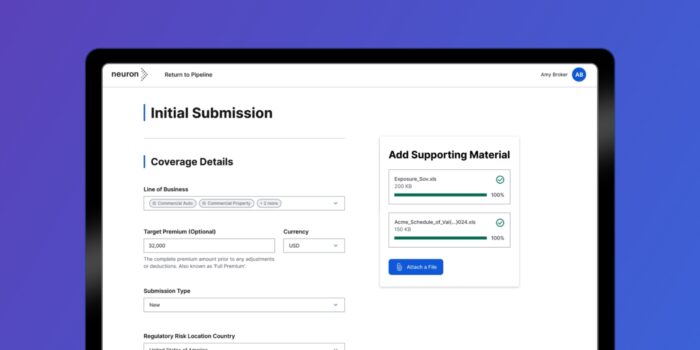How everybody wins in a digitized insurance market
16th April 2024

Although the insurance industry has been relatively slow to adopt digitization, today we’re seeing brokers, carriers and the organizations they insure, converge in a digital marketplace. When this industry transformation comes to full fruition, we’ll see a level of collaboration — and efficiency and transparency — that we’ve never seen before. Co-creation, collaboration and community will serve the industry in ways “go-it-alone” competition never could.
Powered by insurance technology, traditional barriers are fading as insurers converge in a collaborative digital landscape. Pooling strengths to navigate challenges and serve customers is how this industry will create and seize the opportunities of the future.
How did we get here? Digitization: From the 1980s to today
Digitization has become table stakes throughout the financial services industry. This wasn’t always so, particularly for the insurance sector, which was among the slower segments to evolve. Yet with its enormous repositories of data and customer demands, the insurance sector had been well-suited for digitization for some time. And from the dawn of e-banking and early direct-to-consumer insurance products, most stakeholders in insurance and the financial services sector in general have believed that policyholders expect — and deserve — better transactional experiences.
Let’s look at the timeline of moving from “lagging” to “leading” in commercial lines, and how more collaborative marketplaces and initiatives will help us get there:
The 1980s: The dawn of digitization. Carriers start digitizing their processes, adopting computer systems for policy management, claims processing and customer data management.

“Data storage” before the advent of technological transformation in insurance.
The 1990s: The advent of the internet. Carriers begin establishing direct-to-consumer, online channels for customers to price, compare and purchase insurance through portals and aggregators.
The 2000s: Going mobile. With the popularity of the smartphone, carriers develop mobile applications to quote and bind coverage and even submit claims. There isn’t a universal birthdate for InsurTech, but at some point in the era of digitization and personalization, the tech-adept and tech-deficient insurers are pitted against one another. Digital transformation becomes both an internal and external reckoning point.
The 2010s: A “space race” in insurance. The sprint toward InsurTech and digital insurance becomes frenetic, competitive and investment-heavy for early adapters that can launch test balloons. It’s lucrative (even if only temporarily) for unicorn-status disruptors and laden with unknowns for the rest of the industry. Companies become fast followers or decide to wait and see.
By the late 2010s, carriers still relying on systems like Lotus Notes for communications and account warehousing focus on messaging about InsurTech investment while their employees feel stuck in the stone age. Being able to “InsurTech” as a verb becomes a competitive advantage, and then a cultural and talent advantage. Those that can’t innovate on their own acquire solutions or partner with more digitally savvy brands.
The history of digitization in insurance is a case study of what happens when you imbue an age-old industry such as insurance with Silicon Valley DNA, and when generations of policyholders become digital consumers.

In the 2010s, the sprint toward InsurTech and digital insurance was frenetic, competitive and investment-heavy for early adapters with the ability to launch test balloons. The industry became infused with more Silicon Valley-type influence.
While the road to a digital landscape was laden with pain points and lessons learned, the biggest takeaway in 2024 is a shift toward a more unified industry, where digital synchronicity is expected, and everyone has a seat at the table.
Insurance today: A golden era of collaboration
The benefits of moving forward as a united industry in a digital marketplace are numerous. Some of the most noteworthy advantages include:
Collective product development and enhanced customer experience: Through collaborative efforts, insurers can offer personalized and seamless solutions, accessible 24/7 through digital platforms. Having a baseline expectation of digital-first customer competencies improves insurance’s trustworthiness and relevance in the eyes of today’s policyholders. By integrating chatbots, virtual assistants and mobile apps, insurers can provide round-the-clock support and empower policyholders to manage their insurance with ease.
Unified advocacy and fraud prevention: Pooling resources and expertise, insurers are leveraging automation and analytics to streamline operations and combat fraud more effectively. By integrating risk management capabilities, insurers can enhance operational efficiency and reduce costs across the board. Meanwhile, ongoing initiatives at the state and federal levels in the United States are contributing to a better understanding of rating in challenging environments as well as consumer behaviors.
Combining research and development resources on complex technological advancements: Tech-enabled insurance is fertile ground for technological advancements such as artificial intelligence (AI), internet of things (IoT) and blockchain. By collaborating on research and development, insurers and tech partners can harness these innovations to optimize processes, improve risk assessment accuracy and ensure transparent transactions.
Shared data-driven decision making — especially in underwriting: Insurers are uniting to leverage the power of data analytics and combining once-proprietary feedback from claims and risk management to identify risk patterns and market trends. By sharing data and expertise, insurers can make more informed underwriting decisions that drive pricing accuracy, risk assessment and strategic growth.
Improving model accuracy and interpretability: While sophisticated models may deliver superior predictive capabilities, they often sacrifice transparency, leaving stakeholders unclear about the reasoning behind model decisions. Partnering across the industry toward more easily explainable models improves trust and stakeholder buy-in.

The new normal is a more unified approach to digital information.
The broker’s perspective: From isolation to integration
At Neuron, “seamless connectivity” is a fundamental pillar of our truly connected digital market. In our research to identify the biggest hurdles to commercial lines efficiency, the heaviest burden on brokers is raw client data.
Brokerages — and the underwriters they partner with — rely predominantly on the unstructured data (both historical and current) they receive from end-insured clients. It continues to be the broker’s responsibility to format this data into a structured submission for one or many markets to provide quotes. In many ways, a submission is only as good as the quality of data received from the insured. Brokers often must plug any and often all gaps in client data on applications so that the correct quotes are returned from the market.

Without effective data connectivity and accuracy, the job of the broker can become isolating and inefficient.
Without a universal repository for structured insured data, inaccuracies and miscommunications contribute to an inefficient, and often unnecessarily time-consuming, quote process. Many submissions are sent to carriers via email with the supporting data included as attachments. Sometimes a broker may have a portal where carriers can securely retrieve the submission and data. But it often doesn’t provide an efficient mechanism for capturing primary data for client benchmarking and better decision making throughout the insurance value chain.
As many commercial brokerages ramp up efforts to establish proprietary broking platforms, they’re solving for one half of the transactional equation. Often line-of-business-level data standards and mapping to back-end broking systems differs significantly from those of the carriers. The result is translation issues when it’s time to connect to a carrier, whether direct or through an application programming interface (API). Broking platforms are not always configured to seamlessly communicate submissions to insurers’ intake systems.
By gathering business and technical requirements in isolation versus collaborating with carrier partners, brokerages could be missing the big picture. The time and expense to rework these translation layer pain points could be avoided through early collaboration among a trusted group of carriers.
Once a carrier receives a submission via an API, the ideal state is for carriers to return quote responses directly back to the broker’s interface. Quote negotiations and versioning would be maintained in the interface instead of the traditional back-and-forth emails.
The ability to compare multiple carriers’ quotes in one interface is also imperative. Carriers that can connect to this functionality will be able to differentiate themselves early in both the eyes of the broker and the insured.




